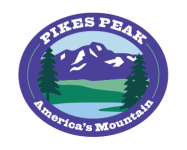Highest visitor center in the world opens with fanfare at 14,115 feet above sea level
The new Pikes Peak Summit Visitor Center, following three years of construction, celebrated its grand opening with a ribbon cutting ceremony Wednesday, June 30. Colorado Governor Jared Polis joined Colorado Springs Mayor John Suthers and Frank Beum from the U.S. Department of Agriculture, Forest Service in commemorating the historic event on the summit of Pikes Peak, a National Historic Landmark. At 14,115 feet above sea level, it is the highest altitude visitor center in the world.
“The City of Colorado Springs and many other stakeholders have long been committed to the task of building a new Pikes Peak Summit Visitor Center that is truly worthy of the majesty and magnificence of Pikes Peak and the luster of its history,” said Suthers. “We now have a visitor center we can all be proud of, a place that William Palmer, Spencer Penrose and the generations of Pikes Peak advocates who have come before us would be proud of. Today we dedicate a building that complements the majesty of a great mountain, and we commence a new era in the history of Pikes Peak and of Colorado Springs.”
The co-hosted celebration also recognized the reopening of The Broadmoor Manitou & Pikes Peak Cog Railway, which has taken visitors to the summit of Pikes Peak since 1891. The Cog, America’s highest railway, reopened in May 2021 after a three-year, $100 million rebuild.
“Colorado Springs now has another world class attraction, and I could not be more proud of the new and improved Cog Railway and Summit Visitor Center,” said Polis. “I have no doubt that we too will continue to summit mountains -- because that’s the Colorado way, and the Cog Railway and Pikes Peak Highway will help get us there. Onward and upward.”
In addition to the breathtaking views, made even more dramatic by the new elevated pathway and overlook designed to help protect the summit’s fragile tundra, there are now digitally interactive displays that bring the history, significance, and geology of the mountain to life both inside and outside the new building, plus fresh menu and retail options. Visitors can still experience the famous high-altitude donut recipe used since 1916.
A predominately one-story form seemingly carved from the southeast side of the peak, the new building offers unobstructed views and is reminiscent of the crags and rock formations found above tree line. It is sited to withstand the extreme environmental conditions of the summit. Nestled into the mountain, exposure to winds that can exceed 230 miles per hour is minimized, while the mass of the building provides sheltered outdoor areas to enjoy the views.
The new building was designed to achieve Leadership in Energy and Environmental Design (LEED) Silver certification, a globally recognized symbol of sustainability achievement. It also strives to achieve the Living Building ChallengeSM (LBC), a two-year certification process, as a highly sustainable, net-zero energy building. Currently, no other buildings in Colorado are fully LBC certified. The entire site was also designed to meet the latest Americans with Disabilities Act (ADA) standards. It was constructed by GE Johnson (Colorado Springs) and designed by GWWO Architects (Baltimore, Md.) in collaboration with RTA Architects (Colorado Springs) as architect of record.
The visitor center and 19-mile highway is operated by Pikes Peak – America’s Mountain (PPAM), an enterprise of the City of Colorado Springs, through a special use permit from the U.S. Forest Service. The total project cost is an estimated $65 million, funded in part by revenue bonds and reserves from PPAM, which generates revenue through highway toll fees and concession sales. The new visitor center is part of the 38,000-square-foot Pikes Peak Summit Complex, which also houses a Colorado Springs Utilities communications facility and the U.S. Army’s High Altitude Research Laboratory.
“I am proud to say that the Pikes Peak Summit Complex embodies the USDA Forest Service goals of harmonizing the environment, restoring natural resources and incorporating the cultural values of our Native American Tribal communities,” said Beum, U.S. Forest Service Rocky Mountain Region regional forester. “The collaborative efforts of several dedicated partners have made this new visitor experience possible for people worldwide to enjoy this beacon of American history in a new and wonderful way.”
The new building is opening in phases, so early visitors can expect to see final construction work taking place and finishing touches being made to the interpretive exhibits and signage. Exterior site work, including paving, is expected to last through September. It replaces the Summit House, which had operated since 1964. The very first summit house was constructed in 1873, and an original wall from that structure has been preserved on the summit. It had welcomed guests like Katharine Lee Bates who authored “America the Beautiful” following her visit to the summit in 1893.

